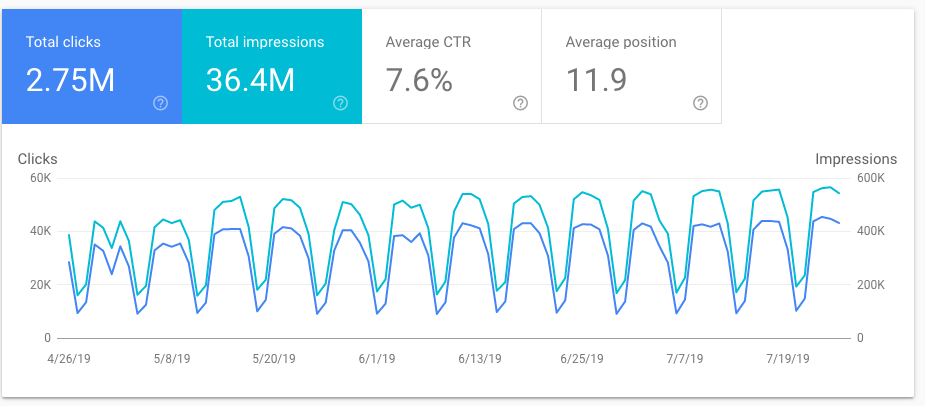|
|
Sponsored Content
The Lounge
What is on Your Mind?
UNIX.com is getting crushed in google search these days
Post 303037275 by Neo on Sunday 28th of July 2019 10:57:36 AM
|
|
6 More Discussions You Might Find Interesting
1. Shell Programming and Scripting
This little doey allows you do fire up a google search right from your terminal.
---------------------------------------------------
#!/bin/sh
#(save me into the path as "google")
clear &&
for i in "$@";
do lynx http://www.google.com/search?q="$@";
done
... (3 Replies)
Discussion started by: JoeTheGuy
3 Replies
2. Web Development
Please let me know if Google search appliance supports JSON or XML interface? If yes please provide some references (3 Replies)
Discussion started by: uunniixx
3 Replies
3. What is on Your Mind?
Hi Unix Gurus,
In my Co. we have intranet site hosted on Unix box. In Explorer there is a text box for searching information on internet. By default it is using Google Custom Search. This search engine is little old one. Now I want to patch this search engine with latest patch. If any one know... (0 Replies)
Discussion started by: sriramis4u
0 Replies
4. What is on Your Mind?
Have just added (after missing for some time), the latest version of Google Site Search for our site in the Navbar Search Menu:
https://www.unix.com/members/1-albums215-picture791.png
Cheers and Enjoy.
Here is the URL for that link in case you need it:
https://goo.gl/P8p82c (4 Replies)
Discussion started by: Neo
4 Replies
5. What is on Your Mind?
Some search results for the keyword "unix" searches:
DuckDuckGo #1
https://www.unix.com/members/1-albums215-picture1254.png
Bing #2
https://www.unix.com/members/1-albums215-picture1253.png
Google #15 (page 2)
https://www.unix.com/members/1-albums215-picture1252.png (1 Reply)
Discussion started by: Neo
1 Replies
6. What is on Your Mind?
Getting a bit more comfortable making quick YT videos in 4K, here is:
Search Engine Optimization | How To Fix Soft 404 Errors and A.I. Tales from Google Search Console
https://youtu.be/I6b9T2qcqFo (0 Replies)
Discussion started by: Neo
0 Replies
LEARN ABOUT FREEBSD
cal
CAL(1) BSD General Commands Manual CAL(1) NAME
cal, ncal -- displays a calendar and the date of Easter SYNOPSIS
cal [-3hjy] [-A number] [-B number] [[month] year] cal [-3hj] [-A number] [-B number] -m month [year] ncal [-3hjJpwy] [-A number] [-B number] [-s country_code] [[month] year] ncal [-3hJeo] [-A number] [-B number] [year] ncal [-CN] [-H yyyy-mm-dd] [-d yyyy-mm] DESCRIPTION
The cal utility displays a simple calendar in traditional format and ncal offers an alternative layout, more options and the date of Easter. The new format is a little cramped but it makes a year fit on a 25x80 terminal. If arguments are not specified, the current month is dis- played. The options are as follows: -h Turns off highlighting of today. -J Display Julian Calendar, if combined with the -e option, display date of Easter according to the Julian Calendar. -e Display date of Easter (for western churches). -j Display Julian days (days one-based, numbered from January 1). -m month Display the specified month. If month is specified as a decimal number, it may be followed by the letter 'f' or 'p' to indicate the following or preceding month of that number, respectively. -o Display date of Orthodox Easter (Greek and Russian Orthodox Churches). -p Print the country codes and switching days from Julian to Gregorian Calendar as they are assumed by ncal. The country code as deter- mined from the local environment is marked with an asterisk. -s country_code Assume the switch from Julian to Gregorian Calendar at the date associated with the country_code. If not specified, ncal tries to guess the switch date from the local environment or falls back to September 2, 1752. This was when Great Britain and her colonies switched to the Gregorian Calendar. -w Print the number of the week below each week column. -y Display a calendar for the specified year. -3 Display the previous, current and next month surrounding today. -A number Display the number of months after the current month. -B number Display the number of months before the current month. -C Switch to cal mode. -N Switch to ncal mode. -d yyyy-mm Use yyyy-mm as the current date (for debugging of date selection). -H yyyy-mm-dd Use yyyy-mm-dd as the current date (for debugging of highlighting). A single parameter specifies the year (1-9999) to be displayed; note the year must be fully specified: ``cal 89'' will not display a calendar for 1989. Two parameters denote the month and year; the month is either a number between 1 and 12, or a full or abbreviated name as speci- fied by the current locale. Month and year default to those of the current system clock and time zone (so ``cal -m 8'' will display a calen- dar for the month of August in the current year). Not all options can be used together. For example ``-3 -A 2 -B 3 -y -m 7'' would mean: show me the three months around the seventh month, three before that, two after that and the whole year. ncal will warn about these combinations. A year starts on January 1. Highlighting of dates is disabled if stdout is not a tty. SEE ALSO
calendar(3), strftime(3) HISTORY
A cal command appeared in Version 5 AT&T UNIX. The ncal command appeared in FreeBSD 2.2.6. AUTHORS
The ncal command and manual were written by Wolfgang Helbig <helbig@FreeBSD.org>. BUGS
The assignment of Julian-Gregorian switching dates to country codes is historically naive for many countries. Not all options are compatible and using them in different orders will give varying results. BSD
March 14, 2009 BSD
